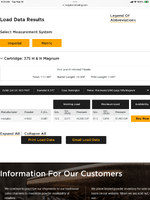Navigation
Install the app
How to install the app on iOS
Follow along with the video below to see how to install our site as a web app on your home screen.
Note: This feature may not be available in some browsers.
More options
Style variation
You are using an out of date browser. It may not display this or other websites correctly.
You should upgrade or use an alternative browser.
You should upgrade or use an alternative browser.
What is the best powder for the .375 H&H?
- Thread starter BlaserNut
- Start date
That actually makes a lot of sense. Thank you for taking the time to explain that to me. I had always been told that it was Barrel Burn Time that was important, that the best load was one that burned to completion just as the bullet exited the barrel. As I think about how many other variables get introduced into theory, I can imagine that such a situation would create very inconsistent shot patterns. I always appreciate good insight.Part of what's going on includes how much more "overbore" the case diameter/capacity is over the bullet. I can't really give you the exact science, but in concept the closer they are, like with .308, .35 Whelen, or .375 H&H, the more benefit you get out of quicker burning powders. The more overbore, the more benefit from slower burning powders.
Heavier or lighter bullets in that same cartridge might mean a little slower or faster burning powder, but it's not as big of a difference compared to when you take that same diameter bullet and put it in a really overbore casing.
That's why you generally find quicker burning powders in .308 Win than you do .243 win, or between .308 Win and the big .30 cal magnums. The more overbore, the more benefit you generally get with slower burning powders.
Bottom line: It doesn't matter how big the caliber is, what's at play is a ratio between caliber to case capacity. The closer the ratios between different cartridges, the closer their powder needs will generally be.
I've received some good education and feedback. As I have a fair amount of H4350 I'll start there. I've also got a fair amount of H4895, so I'll load a batch with that as well. I'm very curious about how the Leverevolution with perform, so I'll make up a batch with that as well. You've all given me a lot of suggestions I can play with, now I've got to start a post on finding more time, haha! I'm going to have some fun!
Similar threads
- Replies
- 22
- Views
- 859
Featured Video
Latest Articles
- TT#64 Josh Boyd Elk Hunting Strategies for Every Season
- Aaron Davidson of Gunwerks
- TT#63 Dirk Durham’s Art of Elk Calling
- BIG Buck Stories with the Dirty Giants Podcast
- TT#62 Brian Barney Hunting Bulls without Calling
- Hoyt Alpha AX-2 SD Review
- Kuiu Kenai vs Outdoor Vitals Vario Hooded Jacket Review
- Hoyt RX-9 Ultra Review
- Hunting Vampire Bucks & Building an Optics Kit
- Darton Sequel ST2 35 Review


